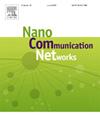使用现成的生物传感器实现警报系统纳米网络的网关
IF 4.7
4区 计算机科学
Q2 ENGINEERING, ELECTRICAL & ELECTRONIC
引用次数: 0
摘要
基于dna的纳米网络在未来的生物医学应用中有着巨大的前景,特别是在早期疾病检测和靶向治疗领域。然而,可靠地将信息从纳米尺度传输到外部监测系统仍然是一个主要挑战。本文探讨了使用商业上可用的连续葡萄糖监测(CGM)传感器作为体内纳米网络和外部设备之间的网关。我们提出了一种新的结构,当检测到与疾病相关的生物标志物时,基于dna的纳米传感器释放葡萄糖作为信号分子。CGM系统可以检测这些血糖激增,实现实时外部通信。在分析了各种类型的生物传感器后,我们发现CGM传感器是最可行的选择,因为它们具有广泛的可用性、生物相容性和测量生化信号的能力。我们提出了几种架构替代方案,计算了可靠检测所需的信号强度,并讨论了潜在的实验验证策略。我们的发现强调了将纳米级诊断与现有生物传感技术相结合的可行和实用途径。本文章由计算机程序翻译,如有差异,请以英文原文为准。
Using off-the-shelf biosensors to implement gateways for alarm-system nanonetworks
DNA-based nanonetworks hold great promise for future biomedical applications, especially in the areas of early disease detection and targeted therapy. However, reliably transmitting information from the nanoscale to external monitoring systems remains a major challenge. This paper explores using commercially available continuous glucose monitoring (CGM) sensors as gateways between in vivo nanonetworks and external devices. We propose a novel architecture in which DNA-based nanosensors release glucose as a signaling molecule when disease-relevant biomarkers are detected. CGM systems can detect these glucose surges, enabling real-time external communication. After analyzing various biosensor types, we found that CGM sensors are the most viable option due to their widespread availability, biocompatibility, and ability to measure biochemical signals. We present several architectural alternatives, calculate the required signal strength for reliable detection, and discuss potential experimental validation strategies. Our findings highlight a feasible and practical pathway toward integrating nanoscale diagnostics with existing biosensing technologies.
求助全文
通过发布文献求助,成功后即可免费获取论文全文。
去求助
来源期刊

Nano Communication Networks
Mathematics-Applied Mathematics
CiteScore
6.00
自引率
6.90%
发文量
14
期刊介绍:
The Nano Communication Networks Journal is an international, archival and multi-disciplinary journal providing a publication vehicle for complete coverage of all topics of interest to those involved in all aspects of nanoscale communication and networking. Theoretical research contributions presenting new techniques, concepts or analyses; applied contributions reporting on experiences and experiments; and tutorial and survey manuscripts are published.
Nano Communication Networks is a part of the COMNET (Computer Networks) family of journals within Elsevier. The family of journals covers all aspects of networking except nanonetworking, which is the scope of this journal.
 求助内容:
求助内容: 应助结果提醒方式:
应助结果提醒方式:


